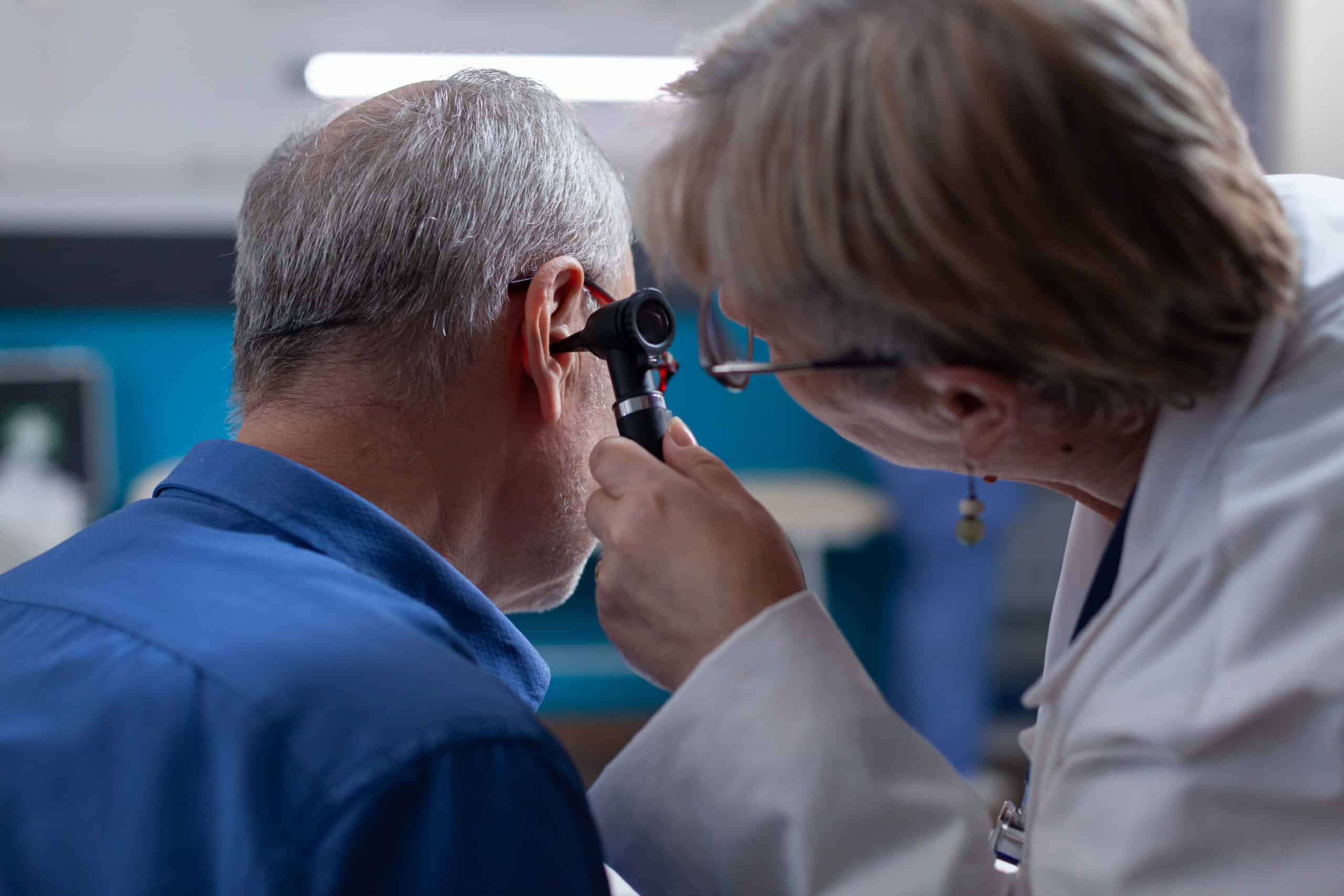Table of Contents
Hearing loss affects millions of people worldwide and has long been considered an irreversible condition, especially when caused by damage to the inner ear’s delicate hair cells or genetic mutations. Traditional solutions like hearing aids and cochlear implants have helped people regain communication and quality of life, but they do not restore natural hearing.
Recent advancements in gene therapy for hearing loss are changing this outlook. Researchers are exploring whether introducing, repairing, or altering genes within the inner ear can lead to lasting genetic hearing loss treatment. However, gene therapy for hearing loss is not approved by the Food and Drug Administration (FDA), and it is not currently widely available as a standard treatment option. This promising field could one day offer patients a permanent solution instead of relying only on assistive devices.
Understanding Hearing Loss and Its Genetic Basis
Hearing loss can arise from many causes—ageing, noise exposure, infections, or trauma—but genetics plays a significant role. Scientists estimate that up to 50–60% of childhood hearing loss is linked to genetic factors.
Genes affect the development and function of:
- Hair cells in the cochlea, which detect sound vibrations
- The auditory nerve, which transmits signals to the brain
- Supporting structures that protect the inner ear tissues
When mutations disrupt these processes, people may experience progressive or congenital hearing loss. Traditional treatments cannot “fix” faulty genes, which is where hearing restoration research through gene therapy comes in.
What Is Gene Therapy for Hearing Loss?
Gene therapy is a biomedical technique that modifies or replaces faulty genes to restore normal function. In the context of hearing, the approach involves delivering therapeutic genes directly into the inner ear.
Methods Used:
- Gene replacement therapy – introducing a functional copy of a defective gene.
- Gene editing (CRISPR-Cas9) – correcting mutations at the DNA level.
- Gene silencing – blocking harmful genetic activity.
By applying these techniques, researchers hope to regenerate lost hair cells or restore inner ear structures. This approach represents one of the most promising experimental hearing loss cures in modern medicine.
Key Advances in Inner Ear Gene Therapy
In recent years, scientists have made breakthrough discoveries:
- Hair cell regeneration in animals: Studies on mice and guinea pigs have shown that delivering certain genes can regrow inner ear hair cells, restoring partial hearing. This discovery offers hope for people who currently rely on hearing aids or cochlear implants.
- Gene delivery via viral vectors: A major challenge in gene therapy is getting the corrective gene safely into the right cells. Researchers are now using harmless, engineered viruses to act as “delivery vehicles.” These viral vectors can transport therapeutic genes directly into cochlear cells with remarkable accuracy, reducing the risk of unwanted side effects.
- CRISPR breakthroughs: CRISPR-Cas9, often called “genetic scissors,” has shown success in repairing deafness-causing mutations in animals. In one landmark study, researchers corrected a single defective gene responsible for hereditary deafness, restoring partial hearing. These results offer powerful proof-of-concept that gene editing could one day reverse genetic hearing loss in humans.
- Improved precision and safety: Beyond animal studies, scientists are also developing advanced tools that allow more precise editing with fewer risks of off-target effects. This makes gene therapy a safer candidate for future human treatments.
Together, these findings fuel strong optimism that inner ear gene therapy could eventually move from experimental trials to real-world medical treatments, offering hope to millions affected by genetic or congenital hearing loss.
Gene Therapy Clinical Trials for Hearing Loss
Clinical trials are already underway, testing gene therapy in patients with hereditary hearing loss.
Some key highlights include:
- Novartis CGF166 trial: Focused on regenerating hair cells using a gene called Atoh1. While results were mixed, it provided valuable insights.
- New CRISPR-based trials: Ongoing studies aim to correct single-gene mutations that lead to childhood deafness.
- Future multi-gene approaches: Since hearing involves many genes, researchers are working on strategies that target multiple pathways.
Though still early, these gene therapy clinical trials mark a major step toward real-world treatment options.
Benefits and Challenges of Gene Therapy for Hearing Loss
Potential Benefits:
- Restores natural hearing rather than compensating with devices
- Provides long-term or permanent results
- Targets genetic causes directly
- Could help both children and adults
Key Challenges:
- Delivering genes safely into the delicate inner ear
- High cost of development and treatment
- Ethical considerations, especially for genetic editing
- Limited data on long-term effects in humans
Despite challenges, the potential benefits make this field one of the most exciting areas of hearing restoration research.
How Gene Therapy Could Complement Current Treatments
While gene therapy is still experimental, it could work alongside existing solutions:
- Hearing aids may still be used for mild to moderate cases.
- Cochlear implants may benefit from gene therapy enhancements that improve nerve function.
- Preventive strategies may arise, allowing doctors to intervene before significant hearing damage occurs.
This combination of approaches could offer patients the best of both worlds: immediate assistance plus long-term restoration.
The Future of Experimental Hearing Loss Cures
Experts believe that within the next decade, gene therapy for hearing loss could become a viable option for patients. With rapid advancements in biotechnology, the hope is to move from animal studies and small trials into broader clinical applications.
If successful, gene therapy could transform how doctors approach genetic hearing loss treatment—shifting from symptom management to true cures.
Conclusion
Gene therapy represents a revolutionary path toward hearing restoration research. While still experimental, it offers hope for millions living with hearing loss, especially those with genetic conditions. As gene therapy clinical trials progress, we may soon witness treatments that go beyond managing symptoms to achieving true cures.
For now, regular hearing tests, proper ear care, and protective measures remain the best way to safeguard your hearing while we wait for the future of medicine to unfold.
Frequently Asked Questions
Not yet. Current studies in animals have shown partial hearing restoration, but results in humans are still limited. Researchers are hopeful, but it will take more time and trials before we know if complete restoration is possible.
People with hereditary or congenital hearing loss caused by single-gene mutations are the most likely candidates. These cases are easier to target because scientists can correct or replace the faulty gene directly.
As of now, gene therapy for hearing loss is still in clinical trial stages worldwide. It has not yet reached regular clinics in Singapore or anywhere else, but progress is moving quickly.
Early studies suggest that gene therapy is relatively safe when delivered directly into the cochlea. However, long-term effects, such as whether the treatment remains stable over decades, are still being studied.
Not immediately. Hearing aids and cochlear implants remain the most practical solutions today. Gene therapy may reduce the need for devices in the future, but for now, they will continue to play a key role.
Experts estimate that it may take 5–10 years before approved therapies become available for patients. This depends on successful trials, regulatory approval, and accessibility.
The inner ear is a relatively closed and well-defined space. This makes it easier for doctors to deliver treatments directly, increasing precision while reducing the risk of side effects elsewhere in the body.
Yes, risks exist, including the possibility of off-target effects or unintended genetic changes. Scientists are actively improving delivery methods to make gene therapy safer and more predictable.
Gene therapy works by fixing or replacing faulty DNA in the cells you already have, while stem cell therapy introduces new, healthy cells to replace damaged ones. Both are being researched for hearing restoration, but they function in very different ways.
You can follow updates from global medical research organizations, check official clinical trial databases, or speak to specialists at The Hearing Centre Singapore for professional guidance and the latest information.

Evlin is passionate about helping people with hearing loss. With years of experience in audiology, she has diagnosed and treated a wide range of hearing conditions across all age groups. She is accredited to conduct comprehensive hearing assessments and provide treatments for patients from newborns to the elderly. Committed to personalized care, she strives to empower patients to fully engage in life with better hearing.
Designation: Clinical Audiologist
Qualification: Bachelor of Health Science (Honours) (Audiology), University of Science Malaysia
Membership: .Society of Audiology Professionals in Singapore (SAPS)

